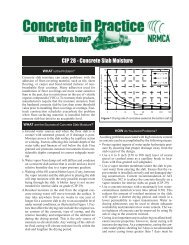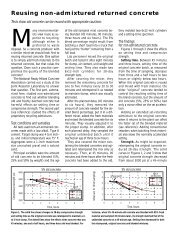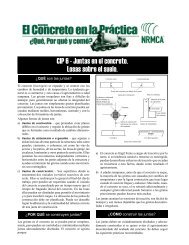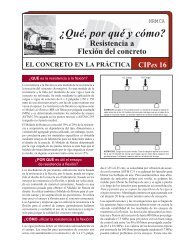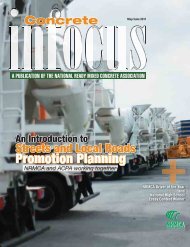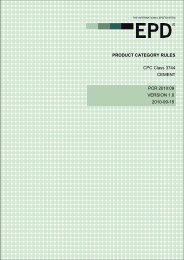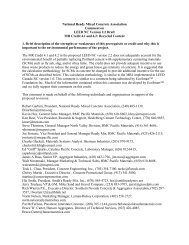2010 NRMCA - National Ready Mixed Concrete Association
2010 NRMCA - National Ready Mixed Concrete Association
2010 NRMCA - National Ready Mixed Concrete Association
Create successful ePaper yourself
Turn your PDF publications into a flip-book with our unique Google optimized e-Paper software.
quality cornerWater Demand – What is it?And what’s it used for? PART IBy Fernando Rodriguez, Rowen <strong>Concrete</strong>, Inc. and Jack Hoy, Swope & Associates (SIKA Admixtures)What is the water demand of thesand that your company is usingto produce concrete? Is it 33 gal/cy or 42 gal/cy? Can there possibly be adifference of this magnitude? What factorscontribute to the water demand of theconcrete? How do you determine the waterdemand of the sand? How can it be used tosave money?Water demand is primarily impacted bythe characteristics of the sand. The primarycharacteristics of sand that impact waterdemand are its particle shape, surface textureand grading. In general, crushed manufacturedsand requires a higher mixing watercontent than natural river sands that have amore rounded shape and smoother surfacetexture.Ground granulated blast furnace slag(slag) and fly ash enhance the slump of a concretemix. A mix design containing 564 lbs/cy of portland cement has less slump than amix that contains 50% Class F fly ash. Flyash, because of its rounded particle shape,reduces the water demand of a concretemixture for a target slump. Air-entrainersand most water reducers also contribute toa higher slump.A standard concrete mixture must beevaluated when estimating the water demand.One might choose a portland cement contentof 564 lbs/cy, coarse aggregate, water, andthe production sand. The concrete mixtureis tested in laboratory conditions to estimatethe quantity of water required to produce a4-inch slump. The following describes proceduresused by the authors.A Type II (MH) cement conforming toASTM C150 is used.The coarse aggregate is manufacturedstone from southern Pennsylvania, conformingto ASTM C33 Size #57.The sand used was washed, naturalsand produced in northeast Maryland andconforms to the requirements of ASTM C33and approved for use by the Maryland StateHighway Administration.turn for five revolutions. Approximately 10pounds of water was weighed, and smallamounts were introduced and allowed tomix with the other constituent materials.We added these small increments until itappeared that a 4-inch slump was attainedupon visual assessment. Slump tesing wasperformed in accordance with ASTM C143.Once a 4-inch slump was obtained, the mixingwas terminated. The unit weight and aircontent was measured and recorded. A setof five compressive strength cylinders wasalso fabricated. All testing was performed inaccordance with ASTM standards.From this trial batch evaluation procedure,the amount of mixing water requiredto obtain the 4-inch slump was equivalentSize ∑ Wt Ret %Pass3/8” 0 100No. 4 2.0 98.0No. 8 15.6 84.4No. 16 26.5 73.5No. 30 42.7 57.3No. 50 77.7 22.3No. 100 96.3 3.7PAN 100.0 0.0Total 2.61Listed below are the mixture proportionsused;Material SP GRAV SSD Wts per cubic yard(lbs) Absolute Volume(cf)Cement 3.15 564 2.87SSD Stone 2.87 1800 10.05SSD Sand 2.59 1454 9.00Mixing Water 1.00 264 4.23Air,% 3.00 0.81A non-air entrained concrete batch of avolume of 0.8 cubic foot was mixed in thequality control laboratory at the author’s productionplant. The moisture content of thecoarse and fi ne aggregate was determined.From experience and past performance,1800 lbs/cy of coarse aggregate was used.For optimum pumping placement, it is estimatedthat 10.0 - 10.3 cubic feet of stone ina cubic yard of concrete appears to providethe best performance.All of the constituents were weighedaccording to design mixture proportions.The stone, sand and small amount of waterwere placed in a 2.0 cubic foot mixer. Themixer was allowed to turn for five revolutions.The cement was then added to themixer. Again, the mixer was allowed toto 300 lbs/cy or 36 gallons per cubic yard.It should be noted at this point that theconcrete sands available in this one smallregional marketplace have a range of as lowas 33 gallons per cubic yard up to as high as44 gallons per cubic yard. With this in mind,it is easily demonstrated how important it isto be well informed as to the demands ofyour concrete sands.Now that the water demand has beendetermined, it can be used for developmentof concrete mixtures and mix optimization.The information can be used to establish thecementitious materials required for differentwater cement ratios, admixture dosagerates and yield targets. Knowing the waterdemand of the local materials can help optimizecementitious material contents andCONCRETE in focus ı 33



